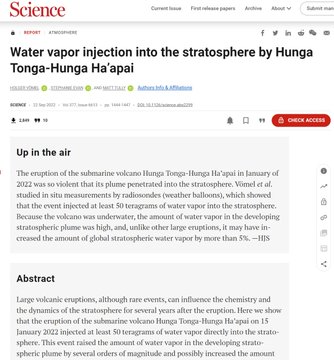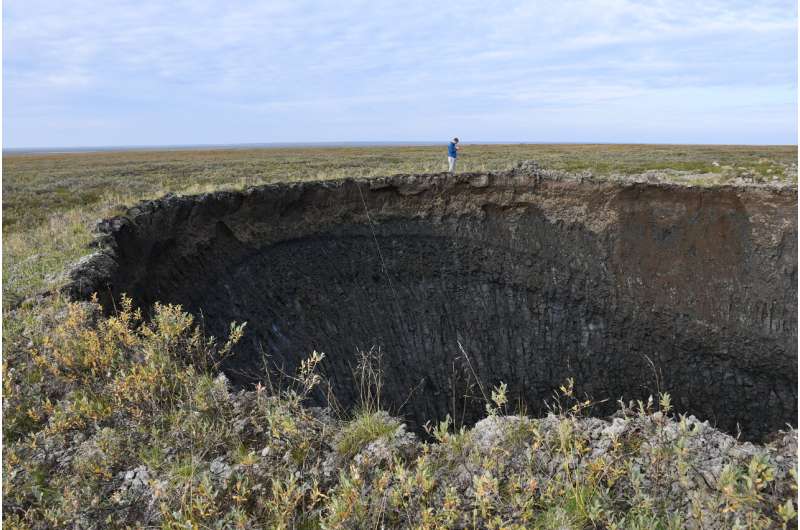Due to this event, last year scientists were forecasting warmer weather ahead.
Strange that no-one mentioned it during the 'Global Boiling' panic over the weather around the Med this year. Maybe it didn't fit the storyline.

Ryan Maue
@RyanMaue
Earlier in March 2023, scientists reported likelihood of warming from the volcanic injection of water vapor into the stratosphere pushing Earth closer to 1.5°C Paris Agreement threshold.
Based upon the last few months, it seems the effect of

on global temperatures may have been greatly underestimated.
It's straightforward how to run a radiative transfer model to determine the impacts of adding 150M metric tons of water to the stratosphere. But, detailed climate model simulations are needed to disentangle the atmospheric circulation changes that lead to non-linear feedbacks.
The climate is "abnormal" right now, aside from the developing El Niño and background climate change.
Ryan Maue
@RyanMaue
Volcanic estimate


Initial scientific estimates were 50-million metric tons of water injected into the stratosphere by Hunga Tonga-Hunga Ha'apai submarine volcano.
Likely off by a factor of 3.
New research suggests 150-million metric tons or almost 40 Trillion gallons of water vapor was injected into the upper-atmosphere.
A lot of it is still up there floating around.


The Hunga Tonga-Hunga Ha'apai Hydration of the Stratosphere
L. Millán, M. L. Santee, A. Lambert, N. J. Livesey, F. Werner, M. J. Schwartz, H. C. Pumphrey, G. L. Manney, Y. Wang, H. Su, L. Wu, W. G. Read, L. Froidevaux
First published: 01 July 2022
https://doi.org/10.1029/2022GL099381
Citations: 33
Sections
PDFPDF
Tools
Share
Abstract
Following the 15 January 2022 Hunga Tonga-Hunga Ha'apai eruption, several trace gases measured by the Aura Microwave Limb Sounder (MLS) displayed anomalous stratospheric values. Trajectories and radiance simulations confirm that the H2O, SO2, and HCl enhancements were injected by the eruption. In comparison with those from previous eruptions, the SO2 and HCl mass injections were unexceptional, although they reached higher altitudes. In contrast, the H2O injection was unprecedented in both magnitude (far exceeding any previous values in the 17-year MLS record) and altitude (penetrating into the mesosphere). We estimate the mass of H2O injected into the stratosphere to be 146 ± 5 Tg, or ∼10% of the stratospheric burden. It may take several years for the H2O plume to dissipate. This eruption could impact climate not through surface cooling due to sulfate aerosols, but rather through surface warming due to the radiative forcing from the excess stratospheric H2O.
Key Points
Following the Hunga Tonga-Hunga Ha'apai eruption, the Aura Microwave Limb Sounder measured enhancements of stratospheric H2O, SO2, and HCl
The mass of SO2 and HCl injected is comparable to that from prior eruptions, whereas the magnitude of the H2O injection is unprecedented
Excess stratospheric H2O will persist for years, could affect stratospheric chemistry and dynamics, and may lead to surface warming
Plain Language Summary
The violent Hunga Tonga-Hunga Ha'apai eruption on 15 January 2022 not only injected ash into the stratosphere but also large amounts of water vapor, breaking all records for direct injection of water vapor, by a volcano or otherwise, in the satellite era. This is not surprising since the Hunga Tonga-Hunga Ha'apai caldera was formerly situated 150 m below sea level. The massive blast injected water vapor up to altitudes as high as 53 km. Using measurements from the Microwave Limb Sounder on NASA's Aura satellite, we estimate that the excess water vapor is equivalent to around 10% of the amount of water vapor typically residing in the stratosphere. Unlike previous strong eruptions, this event may not cool the surface, but rather it could potentially warm the surface due to the excess water vapor.
https://agupubs.onlinelibrary.wiley.com/doi/full/10.1029/2022GL099381










